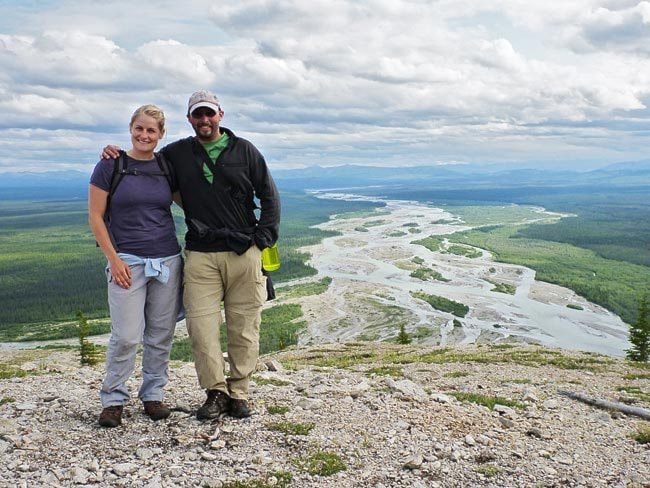The first thing Andrew Little asked me when I spoke to him this week was if I was calling from the Yukon.
“Lucky!” he exclaimed, when I confirmed that I was.
It was perhaps not the typical response from a 17-year-old kid from the suburbs of Toronto.
Little recently returned from an 11-day canoe and hiking adventure down the Wind River in the Peel Watershed. It was his first time in the Yukon.
The trip was part of Lakefield College School’s Irving Expedition, a program that allows students to experience Canada’s northern wilderness.
The Ontario private school sent eight students and two staff to the Yukon in July. It was the first time the expedition had ventured to this territory.
Little knew he wanted to come on the trip even before he started attending Lakefield College in Grade 10.
His mom had taken the family travelling many times, but Little felt he was missing out on seeing his own country.
“I love going to international places and hot vacation-ey kind of places but, I told her that I haven’t even seen Canada yet.”
The students interested in the trip had to apply back in the fall, and the ones who were accepted spent the year learning about the area and preparing for the journey.
They studied the history and geography of the region, the local plants and wildlife, as well as the technical challenges of completing a canoe trip. They practised their flat and white-water canoeing skills.
They were ready, but there will always be things you can’t prepare for, like “losing all sense of time” in the midnight sun.
“I read about the sunlight, the 22-hour sunlight or whatever, but man, I did not know what I was getting myself into,” said Little. “That was special. That was so cool. I’ll remember that forever.”
Not all outdoor enthusiasts enjoy getting caught in a rainstorm, but Little said it was one of the highlights for him.
“One day it poured while we were canoeing, like absolutely downpoured. We could see ourselves just canoeing into the wall of rain, and I loved it,” said Little.
“As soon as we hit it, it wasn’t that bad, but when we were in it we were paddling and I just couldn’t see. I was in the stern and I was yelling at my buddy Max, ‘If you see anything, if we’re going to run into anything, you gotta tell me because the rain’s just crazy, I can’t see!’”
The trip was all highlights and no low-lights for Little, who said that even the long days of paddling just added to the adventure.
“Just being in there for a long time in the strong current, it was tiring, but because it was so much fun you didn’t really think about, you know, the hardships of the trip.”
Alaina Robertson, a teacher at the school, was one of the leaders of the expedition.
Unlike her students, Robertson was no stranger to the Yukon.
Although originally from Toronto, she had spent six summers working as a guide for Whitehorse-based Nahanni River Adventures, leading trips mostly in the Northwest Territories.
She was thinking about quitting guiding before she joined that outfitting company, she said, but the allure of the North drew her in and she hasn’t quite been able to leave since.
“I keep going back because it’s so beautiful to go up there, and it’s so different from home that I find that I miss it when I’m not there,” said Robertson.
She had previously taught physical geography to all of the students on the Wind River trip. Being on the land with them helped bring the lessons of the classroom to life.
“They learned all the components of a physical environment, but to actually see it in a natural context, it kind of makes those connections, and makes their understanding a lot better of what they actually did learn.”
In addition to learning about the environment, the students quickly absorbed the routines of life on the river.
“They just worked like a well-oiled machine by the end of it. They understood what needed to happen once we got to camp, and unpacking and doing food, and just organizing things and setting up.”
Not long into the trip, Robertson noticed the students becoming more confident. They quickly got comfortable taking time for themselves to be in the environment, heading out alone with a book or a fishing rod, said Robertson.
“They were nervous at the beginning and excited, and that calmness just kind of settled on of all of them as the trip went on, and they kind of just fell into this groove, which was pretty neat.”
The political fight over land-use planning in the Peel watershed was something that Robertson talked about a little bit with the students while they were on the trip, Little remembered.
The battle became real for Little when they stopped for lunch at a beach that was littered with “flakes and hunks” of coal.
In that moment he realized why people were so interested in developing the area, but also how much he didn’t want that to happen, he said.
“I want to (one day) take my kids there, and have it be the same, be able to tell them, ‘We camped on that spot.’”
Pristine wilderness is hard to come by in southern Ontario, and that is exactly what made the trip so special for Little.
“This is probably my favourite part of the trip: being able to dump out my water bottle because it wasn’t cold enough, and just being able to dip it back in the river while I was canoeing and just take a chug. I loved that.”
Contact Jacqueline Ronson at
jronson@yukon-news.com
